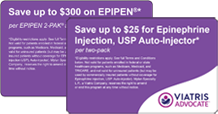
For Pharmacists
It's important to know that not all epinephrine auto-injectors look and function the same way.1 Learn about other important considerations when dispensing epinephrine auto-injectors.
For School Nurses
Find important information for school nurses, including details about the EPIPEN4SCHOOLS® program, creating a 504 Plan and a link to a step-by-step video to help train school staff.
For Emergency Department Physicians.
Learn what patients experiencing anaphylaxis are instructed to do after using their EPIPEN® (epinephrine injection, USP) Auto-Injector or its authorized generic and how ED physicians may play a role.
Considerations for consultation with an allergist
Because the evaluation and diagnosis of anaphylaxis, as well as its long-term management, can be complex, patients with a history of anaphylaxis should be considered for referral to an allergy-immunology specialist.2-4 Such specialists can take a detailed allergy history, coordinate appropriate testing, assess the risks and benefits of therapeutic options and advise the patient on avoidance approaches.3
Special Offers
Viatris offers Access and Savings Programs for eligible patients. See Terms and Conditions.
There’s only one recommended first-line treatment for anaphylaxis.
heading
Important Safety Information (the following information applies to both EPIPEN and its Authorized Generic)
EPIPEN (epinephrine injection, USP) 0.3 mg and EPIPEN JR (epinephrine injection, USP) 0.15 mg Auto-Injectors are intended for immediate administration as emergency supportive therapy only and are not intended as a substitute for immediate medical or hospital care. In conjunction with the administration of epinephrine, the patient should seek immediate medical or hospital care. More than two sequential doses of epinephrine should only be administered under direct medical supervision.
Rare cases of serious skin and soft tissue infections have been reported following epinephrine injection.
References
- Ram FSF, Hoare K, Arroll B, Hoare S. Epinephrine self-administration in anaphylactic emergencies: comparison of commonly available auto-injectors. J Asthma Allergy Educ. 2012;3(4):178-181.
- Boyce JA, Assa’ad A, Burks AW, et al. Guidelines for the diagnosis and management of food allergy in the United States: report of the NIAID-sponsored expert panel. J Allergy Clin Immunol. 2010;126(6)(suppl):S1-S58.
- Lieberman P, Nicklas RA, Randolph C, et al. Anaphylaxis—a practice parameter update 2015. Ann Allergy Asthma Immunol. 2015;115(5):341-384.
- Simons FE, Ardusso LR, Bilὸ MB, et al; World Allergy Organization. World Allergy Organization guidelines for the assessment and management of anaphylaxis. World Allergy Organ J. 2011;4(2):13-37.

This site is intended for US healthcare professionals.
If you are a patient, please check out our site for patients.

Prescribing Information
Please select from the following:

Patient Information
Please select from the following:



